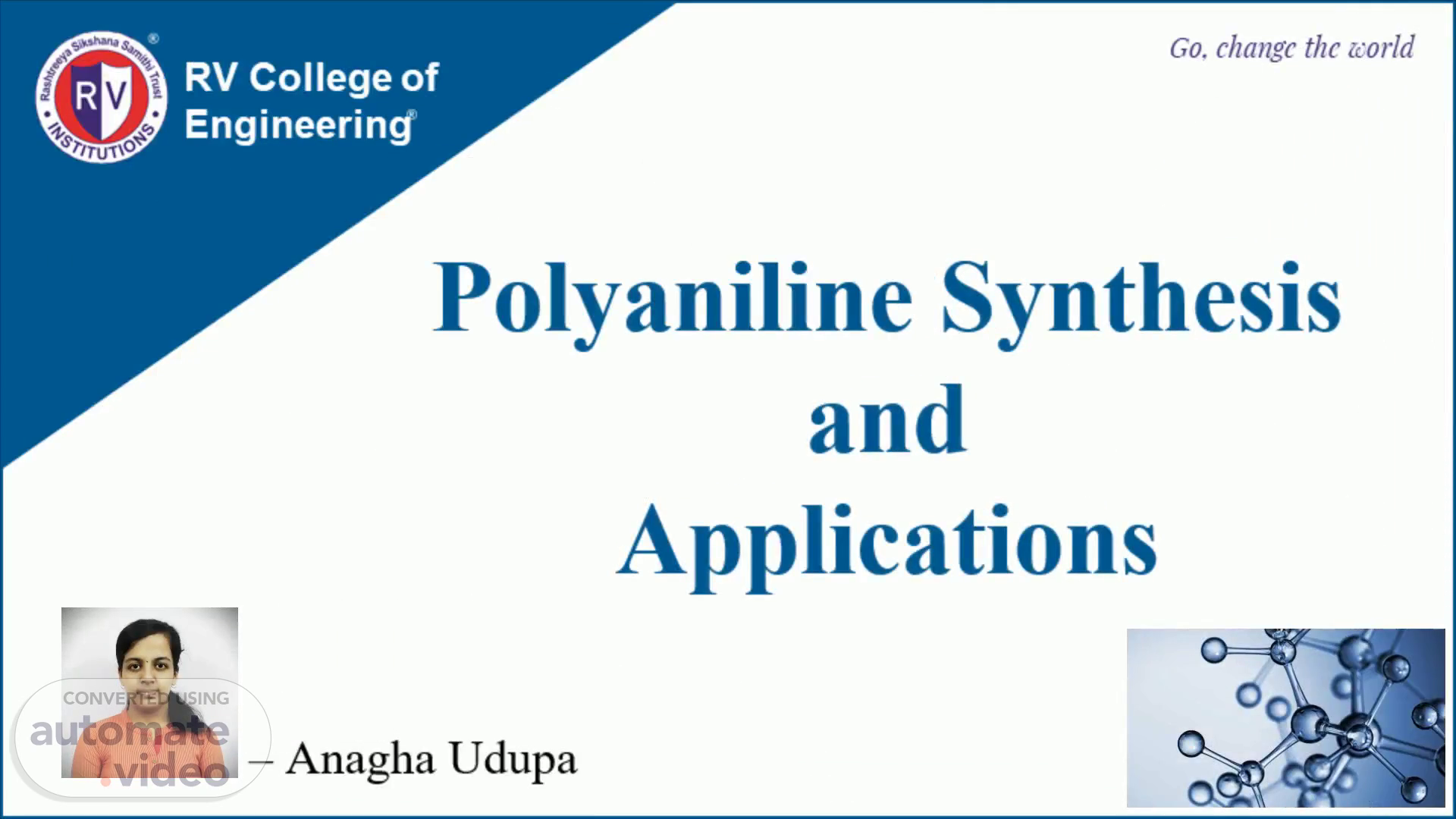
Page 1 (0s)
Polyaniline Synthesis and Applications. – Anagha Udupa.
Page 2 (8s)
What is polyaniline? A polymer of aniline; especially one that is a solid material which conducts electricity when doped with protons or other charge carriers. It (PANI) is a conducting polymer and organic semiconductor of the semi-flexible rod polymer family. The compound has been of interest since the 1980s because of its electrical conductivity and mechanical properties. Polyaniline is one of the most studied conducting polymers..
Page 3 (28s)
Among all the conducting polymers, polyaniline holds a special position, due to its unique properties such as low cost of monomers (aniline), distinguishable elec trical properties, excellent redox reversibility, high environmental stability and can be easily polymerized in labs either by chemical or electrochemical methods The commercial plastics which are made up of saturated organic polymers are insulators, in contrast to those plastics are made up of conjugated polymers have the property of semiconductors. Synthesis: Polyaniline can be synthesized both by chemical and electrochemical method. By electrochemical technique PANI can be deposited on various conductive substrates in the form of thin films, especially for the use in electronic devices. In chemical synthesis, typically, aniline monomers are oxidized by oxidizing agents such as ammonium persulfate , hydrogen peroxide, ferric chloride , and ceric nitrate/sulfate) in acidic medium (hydrochloric acid and sulfuricacid)..
Page 4 (1m 6s)
. Preparation using ammonium persulfate:. NH2 Aniline (NH4)2S208+ 1M HCI Oxidant n Conductive Polyaniline.
Page 5 (1m 15s)
NH2 NH NH NH2 - -214 Polyaniline. Mechanism of synthesis.
Page 6 (1m 23s)
Alternative methods for preparation of polyaniline: 1.Ch emical in situ polymerization of aniline in a matrix or in a solution with a matrix polymer; 2.Dispersion polymerization of aniline in the presence of a matrix polymer in a disperse or continuous phase of a dispersion 3.Emulsion polymerization 4.Solution blending soluble matrix polymers 5.Dry blending 6.Melt processing.
Page 7 (1m 42s)
Applications of Polyaniline: Polyaniline based conductive polymers can be used neat, or as blends and compounds with commodity polymers. Several prototype objects and articles have been made of these compounds with polyethylene, polypropylene, polystyrene, soft PVC, PMMA, phenol-formaldehyde resins, melamine formaldehyde resins, epoxies, and thermoplastic elastomers . The solution processing properties of polyaniline based conductive polymers make totally new product ideas possible. These include electroactive inks, paints, coatings, and adhesives, electrochromic “smart” windows, electrically conductive transparent films, and conductive high performance fibres. Solution processing (material depositing) can be carried out using the neat material or a blend..
Page 8 (2m 12s)
Used as e lectrostatic discharge (ESD) protection materials: One of the important applications of these materials is the protection from electrostatic discharge (ESD) . ESD causes problems when handling sensitive electronic components, explosive chemicals or dry powders. The use of, e.g. antistatic materials in specific environments reduce ESD related problems, such as the amount of damaged valuable end products in an assembly line. The controllable conductivity in ESD protection materials is one of the basic benefits of conductive polymer PANI. In terms of yarn and fiber, Polyaniline (PANI) can be applied for – conductive textiles – antistatic floors – automotive industry and many more ..
Page 9 (2m 41s)
Polyaniline in cancer treatment : Chemotherapy is a conventional approach in the treatment of cancer. However, undesired side effects, discomfort of patients, and multi-drug resistance of cancers limit its efficiency. Therefore, a chemotherapeutic agent has been incorporating into responsive materials to induce synergistic anticancer effects. A multifunctional hybrid polymer system comprising of PANI NPs as PTA and Methotrexate (MTX) as an anticancer drug for combined photo–chemotherapy. In in vivo experiments, mice treated with combined therapy showed a higher tumor growth inhibition rate than PTT or chemotherapy alone, due to a synergistic effect, implying that combining PANI with other chemotherapeutic agents can exert better efficacy..
Page 10 (3m 12s)
There has been growing interest in the potential use of PANi in the field of nanomedicine, tissue engineering, cell stimulation drug delivery etc. T he conjugated PANi composites show, indeed, improved properties in biomedical application. Conductive PANI-based nanocomposites represent a new, but not yet completely explored, area of quantum dots where promising results and unresolved technology challenges both call for opportunities for deeper studies and developed research. There are some major limitations, such as processability and physicochemical properties on PANI applications and its nanocomposites into sensor practice. PANI is gaining increasing interest from the scientific community. However, from an industrial perspective, some of the challenges have important drawbacks on regulatory and quality assurance issues, thereby explaining the relatively low amount of sensor data related to PANI. Thus further innovation in this area is a boon to mankind..
Page 11 (3m 49s)
Thank you.